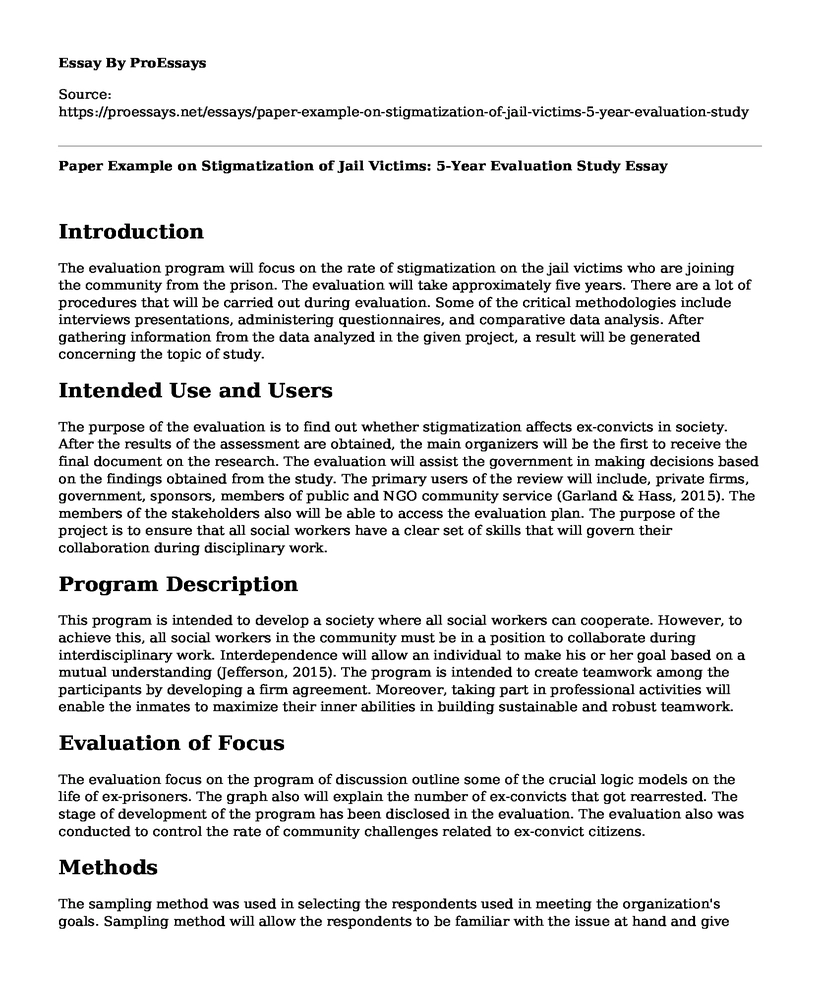Introduction
The evaluation program will focus on the rate of stigmatization on the jail victims who are joining the community from the prison. The evaluation will take approximately five years. There are a lot of procedures that will be carried out during evaluation. Some of the critical methodologies include interviews presentations, administering questionnaires, and comparative data analysis. After gathering information from the data analyzed in the given project, a result will be generated concerning the topic of study.
Intended Use and Users
The purpose of the evaluation is to find out whether stigmatization affects ex-convicts in society. After the results of the assessment are obtained, the main organizers will be the first to receive the final document on the research. The evaluation will assist the government in making decisions based on the findings obtained from the study. The primary users of the review will include, private firms, government, sponsors, members of public and NGO community service (Garland & Hass, 2015). The members of the stakeholders also will be able to access the evaluation plan. The purpose of the project is to ensure that all social workers have a clear set of skills that will govern their collaboration during disciplinary work.
Program Description
This program is intended to develop a society where all social workers can cooperate. However, to achieve this, all social workers in the community must be in a position to collaborate during interdisciplinary work. Interdependence will allow an individual to make his or her goal based on a mutual understanding (Jefferson, 2015). The program is intended to create teamwork among the participants by developing a firm agreement. Moreover, taking part in professional activities will enable the inmates to maximize their inner abilities in building sustainable and robust teamwork.
Evaluation of Focus
The evaluation focus on the program of discussion outline some of the crucial logic models on the life of ex-prisoners. The graph also will explain the number of ex-convicts that got rearrested. The stage of development of the program has been disclosed in the evaluation. The evaluation also was conducted to control the rate of community challenges related to ex-convict citizens.
Methods
The sampling method was used in selecting the respondents used in meeting the organization's goals. Sampling method will allow the respondents to be familiar with the issue at hand and give their useful feedback of integrity. The interview will be the number one methods that will be used during the collection of data. The methods that will be deployed in this evaluation are both quantitative and qualitative analysis. Lastly, the data analysis method that will be used during the assessment will be comparative.
Analysis and Interpretation of Plan
The information will be analyzed through the use of the comparative method. The data retrieved from the study will be compared with the available data based on the previous research work. After the completion of the research, the results will be taken to sponsors and key program directors for interpretation.
Dissemination and Sharing Plan
The findings of this particular program will be presented to the sponsors or directors of the research. The board of governors later will analyze the findings and come up with a specific solution. After the information has analyzed and presented to the sponsors, the final result will be taken to the government. The government later will update the public by publishing the findings on the dailies.
References
Garland, B. E., & Hass, A. Y. (2015). An outcome evaluation of a Midwestern prisoner reentry initiative. Criminal justice policy review, 26(3), 293-314. Retrieved from https://journals.sagepub.com/doi/abs/10.1177/0887403413514438
Jefferson, B. J. (2015). From prisons to hyperpolicing: Neoliberalism, carcerality, and regulative geographies. In Historical Geographies of Prisons (pp. 185-204). Routledge. Retrieved from https://www.taylorfrancis.com/books/e/9781315724997/chapters/10.4324/9781315724997-11
Cite this page
Paper Example on Stigmatization of Jail Victims: 5-Year Evaluation Study. (2023, Jan 29). Retrieved from https://proessays.net/essays/paper-example-on-stigmatization-of-jail-victims-5-year-evaluation-study
If you are the original author of this essay and no longer wish to have it published on the ProEssays website, please click below to request its removal:
- Development of British Constitution Paper Example
- Range of Criminological Theories and Quantity of Homicides Incidents Paper Example
- Research Paper on The Homeless Senior Accommodation Program (HOSAP)
- Essay Example on Drug Addiction: A Long-Term Mental Disorder
- Women Seeking Fulfilment in Societys Expectations - Essay-Sample
- Essay Sample on Myths of Ancient Greece: Gender Roles & Stereotypes
- Ethnic Diversity in Books - Free Essay Sample







